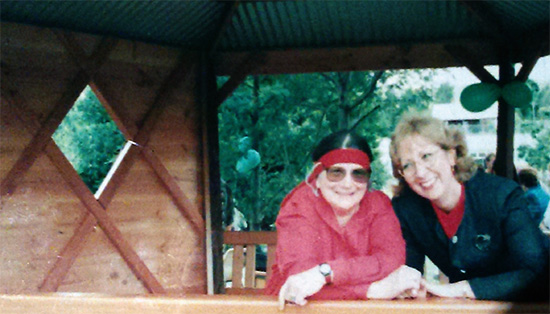Irish Women

The Wharves area was an intersection of paths, trails and events that captured so many important aspects of the day and was a window onto a number of features of the dynamic, pioneering colony. It was a frontier in many ways.
Woman played a big role in defining the ambience of those pioneering days. Newly arrived migrants from Ireland, refugees from the potato famine, ran the Ship Inn Pub on the waterfront on the corner of Bunbury and Maribyrnong Streets from 1847 and ran the punt over the river in front of the Ship Inn.

behind locomotive on the goods railway siding that runs alongside Maribyrnong Street.
Authors Maureen Lane and Joan Carstairs who wrote a book, ‘Pubs, Punts and Pastures’ (link to download below), about early women pioneers in the western suburbs, said, we found ‘that much of the actual work of settlement was done by a lot of women whose husbands , conveniently or inconveniently, died young. They left young widows with large families and acres of fairly barren, very dry, stony land to complete the job alone that had been started by a husband and wife team.’

The book looks at the lives of seven women, all related and connected in ways. A number of these women were part of the history of this west bank of the Maribyrnong River that gave birth to Footscray. Margaret Picket, kept a herd of dairy cows on the banks of the Maribyrnong near Footscray Park and ran the Ship Inn and the punt in front of it.
A few short years later in the early 1850s Margaret’s sister, Anne Delaney, came to the area and they ran a punt together further up river where Lynch’s Bridge is now, right near the Flemington Racecourse. In 1853 Anne Delaney bought the land where the Footscray Community Arts Centre is. In 1873 she sold the land to Henderson who established the ham and bacon curing works, known as ‘The Piggery’.
In 1854 Anne built the Junction Hotel on the corner of Bunbury Street and Whitehall Street.
The family has left its mark with local street names, such as Picket Street, Ann Street, Margaret Street and Catherine Street in Footscray.





Joan Cartstairs painstakingly researched the life of one of these women, Anne Dowd, and her research tells a story that would otherwise be lost in time. Anne Dowd came from Ireland at age 22 in 1849 with husband and young son and gave birth to her baby daughter en-route. The family ran the Punt Inn and operated the punt eventually they bought land of their own. When her husband died and Anne re-married, her land became the property of her new husband – as that was English law. They built, and she ran, the Rising Sun hotel in Footscray. After her second husband died Anne was arrested for cursing in public and sent to gaol when she discovered that he had spent all of their savings and slowly sold off all of her land to enable his status as a gentleman. She outlived all of her children and died a pauper in Geelong gaol at age 75.
Pioneer Women’s Shelter (the hut)
In 1995 Maureen Lane and Joan Carstaits approached the Living Museum to help design a monument to commemorate the women in their book, and others like Anne Dowd who were buried in unmarked graves.
The Pioneer Women’s Shelter was comissioned in 1997 by St Albans History Society and was designed and built by Melbourne’s Living Museum of the West on the banks of the Maribyrnong River in Pipemakers Park.
Sales of the popular book ‘Pubs, Punts and Pastures’, funded the design and construction of the shelter.
The design of this small building is a collaboration between the authors of this book (and members of St Albans History Society) Joan Carstairs and Maureen Lane and the artist and museum associate, Kerrie Poliness. A shelter was chosen as an appropriate form to commemorate the contribution of Pioneer women, reminicent of the work of Caroline Chisholm towards improving the conditions of trecking from early Melbourne to the gold fields. The scale of the building was determined by ‘what felt like a comfortable distance to sit across from someone else and have a chat’.
The materials of timber and bluestone reflect local materials; the timber used for construction is recycled from the demolition of adjacent Australian Defence Industries buildings.
The shelter (nicknamed ‘the hut’ by Joan Carstairs) on the west bank of the Maribyrnong River, as well as commemorating Irish pioneer women in general is dedicated to six women in particular whose contribution to society was especially substantial. Their names are inscribed within the shelter on the bluestone plaque produced by Purdy’s traditional Stonemasons of Williamstown.
Many people associated with the project and the Museum volunteered their skills and knowledge towards the enhancement of the building. For example, Purdy’s kindly donated the construction of the bluestone path leading to the shelter, Rodney Purdy crafted an inlaid sandstone shamrock in acknowledgement of his Irish heritage. Some of the members of the Koorie apprentice gardening team (based in Pipemakers Park) became involved in the planting around the building in acknowledgement of their Irish ancestors.
In 2015 the hut was repaired by St Albans History Society and graffitti proofing was generously sponsored by Calcorp.




Pioneer Women’s Shelter in 1997.

